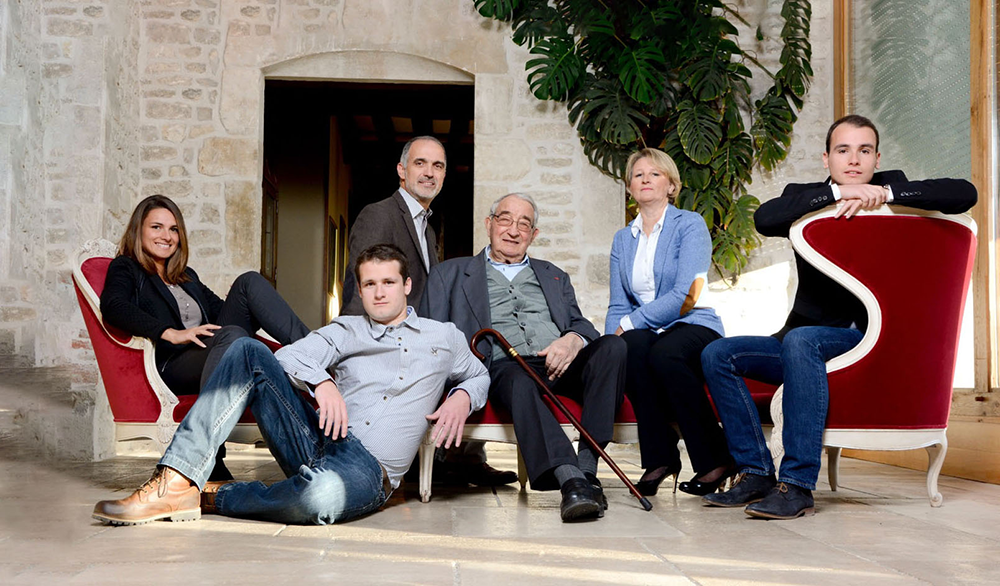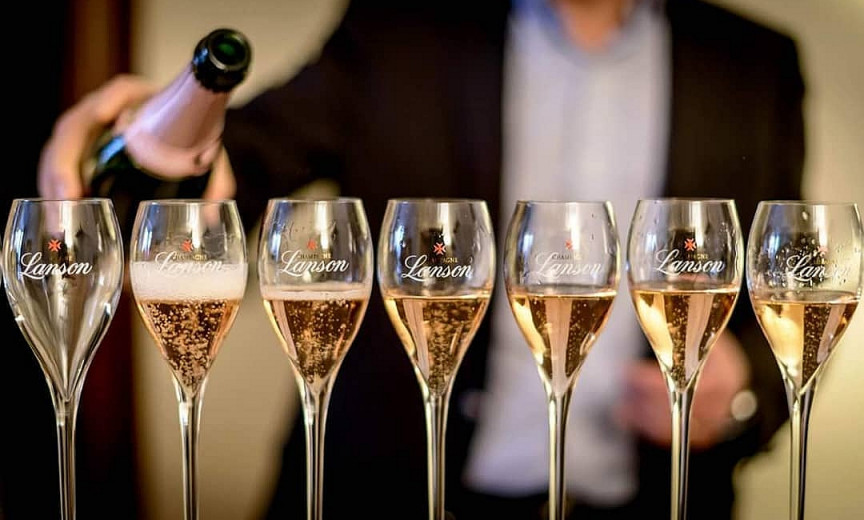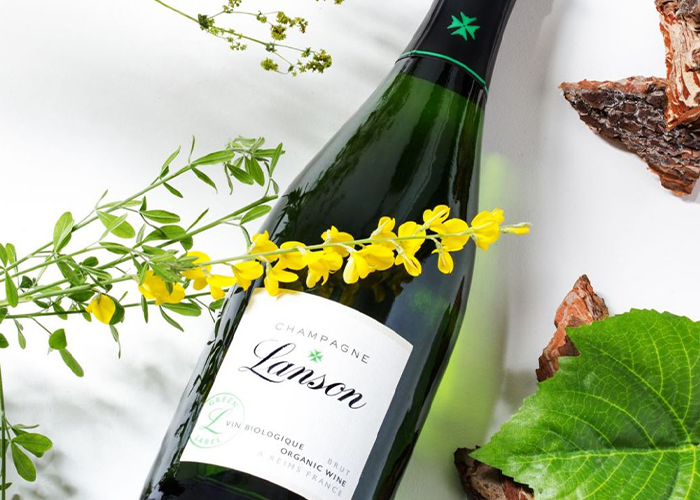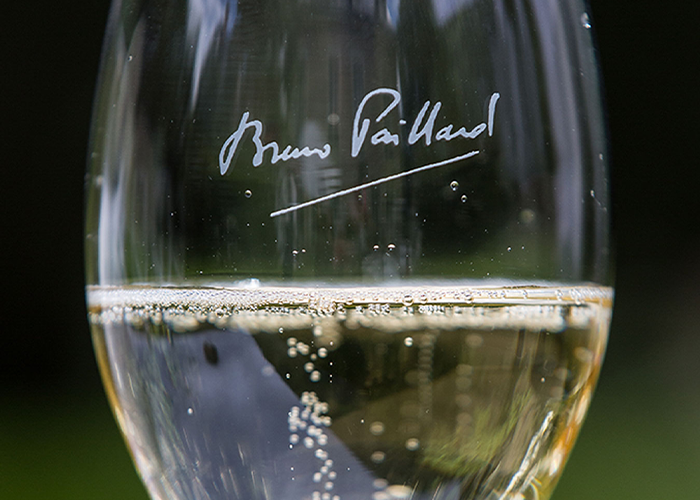Wine Warehouse offers a small, curated Champagne list consisting of four unique, effervescent personalities: Champagne Drappier, Bruno Paillard, Lanson and Jacquart. A Champagne lover will want all four on-hand for the holidays. Here’s a guide to help you rule your holidays with our fine Champagnes, along with some little-known facts that makes each of them stand out from all those other, less exciting houses.

Rule The Holidays With These Champagnes
Dec 02, 2019

Drappier
Drappier is a Champagne house helmed by eight generations of family ownership. Today, siblings Charline, Hugo and Antoine Drappier farm, vinify, bottle and sell their prestigious cuvées under the guidance of parents Michel and Sylvie as well as the watchful eye of venerable grandfather André.
The heart of Champagne Drappier’s style was established by Georges Collot, maternal grandfather of Michel Drappier, in the 1930s when he made the controversial decision to plant Pinot Noir in his homeland Aube, far south of Reims and Épernay. Since then, Drappier has featured Pinot Noir as the dominant grape in their house blends making Georges Collot as they say, famous. Today locally, they still call him “Papa Pinot.”
Drappier Champagnes carry the lowest dosage of sulfur of any house in Champagne. Michel Drappier’s extreme sensitivity to sulfur led him down this path. Using less sulfur can enhance essential flavors and colors which are both expressed vibrantly in Drappier Champagnes. Additionally, Drappier has adopted a dosage or “liqueurs d’expédition” that is also very low. Interestingly, it’s a homemade dosage recipe they created by slowly aging the elements in oak casks and then in demijohns for more than 10 years.
There are also some intriguing happenings flourishing in the vineyards where Drappier’s vines are farmed organically. The family has undertaken the responsibility to cultivate a collection of almost forgotten historical Champagne grape varieties including Arbane, Petit Meslier and Blanc Vrai. To celebrate these uncommon native Champagne varieties, Drappier makes a cuvée dedicated to forgotten grapes called Quattuor Cuvée, composed of Arbane (25%), Petit Meslier (25%), Blanc Vrai (25%) and Chardonnay (25%). Wine Warehouse is lucky to have this alluring assemblage to offer to fans of Drappier.


Two seasonal favorites are the ever-popular Drappier Carte d’Or and Drappier Brut Nature, bottled without the use of sulfur. For special occasions, it’s worth venturing into Charles de Gaulle Cuvée, an homage assemblage dedicated to a loyal Drappier customer, the great French President, Charles de Gaulle. Before moving on, take a peek at the rare single-vineyard vintage Champagne Drappier Grande Sendrée—a cuvée that takes its name from a parcel of land reduced to a blanket of cinders following a notorious fire that ravaged Urville in 1838.
It’s refreshing to note that Drappier’s Rosés are all made via the rare “saignée” method and that Drappier is currently the only Champagne house to bottle a Brut Nature Saignée Rosé Champagne. The saignée method is the most challenging way to make rosé sparkling wine. It involves “bleeding” off just the right amount of pink juice from a cluster of red grapes following a limited period of skin contact, instead of simply blending red and white wine to form a pink wine, as is more commonly done in the appellation.

“This bright and zesty Champagne is lightly juicy and appealing, offering flavors of Honeycrisp apple, ripe white cherry, biscuit and pickled ginger. Balanced and lacy in texture, with a lingering, spiced finish. Drink now through 2022.” 92pts Wine Spectator A “Top Value” for 2017; 90pts Wine Enthusiast; 90pts Wine Advocate

“Lightly floral on the nose, with hints of lavender and verbena, and spicy on the palate, offering ground clove and anise accents to the flavors of pastry dough, wild cherry, golden raisin, grated coconut and fleur de sel. Harmonious and elegant throughout, presenting a long, mouthwatering finish.” 92pts Wine Spectator

This champagne presents itself in a ravishing pale yellow robe with topaz nuances. Time has used its patina to reveal the wine’s complexity.

Lanson
Lanson has been making their Champagnes in the same original style since 1760. At that time, and up until the mid-1970s, Champagnes routinely did not go through malolactic fermentation. Today they almost all do. Lanson is one of only three top Champagne producers who continue to eschew malolactic fermentation in order to stay focused on making crisp, focused wines with lively acidity.
Lanson’s grapes are sourced from only Premier Cru and Grand Cru vineyards. The house blends are Pinot Noir dominant and even the non-vintage cuvées, Lanson Black Label Brut, Lanson Rosé Label, and Lanson White Label (Sec) are produced incorporating lees-aged reserve wines covering over 10 different harvests to add depth and richness. The amazingly well priced 2008 Lanson Gold Label (2008 is an ace vintage by the way), roughly half Pinot Noir and half Chardonnay, is made exclusively from Grand Cru fruit and aged in the cellars at Lanson for a minimum of five years.


Creating a buzz in the wine world lately are some exciting new Lanson cuvées that only recently have been unveiled including Lanson Clos Lanson and Lanson Green Label.
The very first vintage of tête de cuvée Lanson Clos de Lanson was 2006. Only 7,870 bottles were produced from a one-hectare, walled in, single-vineyard plot in the centre of the city of Reims, overlooking the Notre-Dame de Reims Cathedral. It’s the only vineyard within the walls of the city. This special vineyard, affectionately known as Lanson’s ‘Secret Garden,’ is also home to the Clos Lanson beehives, so keep alert if you go there. A tiny quantity of 2007 Clos Lanson remains available via allocations from Wine Warehouse. Speak up now or miss this one!
Lanson is very proud to offer Lanson Green, a brand new, certified organic cuvée. This new “bio” Champagne is produced from 16 hectares of certified organic parcels in Verneuil, in the heart of the Marne Valley, that Lanson acquired in 2011. The blend is 50% Pinot Noir, 20% Chardonnay and 30% Pinot Meunier, with a dosage of 6-grams/liter and an aging or “en-tirage” minimum of three years.
It’s often a sign of excellence when the queen awards a royal warrant to a merchant. The House of Lanson continues to hold the royal warrant that it first obtained in 1900 when Henri-Marie Lanson was awarded by Queen Victoria the title, “Purveyor of Champagne to Her Majesty.” Look for the gold crown on the top foil of each bottle of Lanson Champagne and you’ll see the official stamp declaring Lanson as a purveyor by appointment to H.M. Queen Elizabeth II.
Tennis and Champagne anyone? The British consider Lanson and tennis a perfect pairing! The house has been associated with the Wimbledon tennis tournament since 1977. More recently Lanson has been selected as the official supplier of Champagne for the championships.

“This creamy Champagne is bright and citrusy, offering an expressive and well-meshed mix of ripe blackberry, pastry dough and pickled ginger flavors. Racy finish. Disgorged October 2016. Drink now through 2021.” 91pts Wine Spectator; 91pts Wine Enthusiast; 90pts Wine Advocate

“A racy streak of tangy mineral underscores the flavors of pink grapefruit granita and slivered almond in this vibrant version, with hints of toast and orchard blossom. Well-knit and elegant, with a lasting, spiced finish. Disgorged July 2016. Drink now through 2022.” 92pts Wine Spectator; 92pts Tasting Panel; 91pts Wine Enthusiast; 91pts James Suckling

“Notes of oyster shell, graphite and spice are a fresh and aromatic entry for this vibrant Champagne, layered with firm, focusing acidity and flavors of poached apricot, black cherry, lemon curd and slivered almond. Offers a lovely, creamy texture and a juicy quality to the mineral-laced finish. ” 94pts Wine Spectator; 92pts Decanter; 93+pts Wine Advocate


Bruno Paillard
Bruno Paillard was born in Reims in 1953 and got his start in the Champagne business as a village broker in 1975. At the age of 27, he made the ambitious decision to enter into the realm of Champagne production himself, undeterred by having nary a penny, vineyard or cellar to his name. But he did own a vintage Jaguar that he sold in 1981 for just enough cash to get started making bubbles in rented cellars.
By 1984, newcomer Paillard had sold enough Champagne to build the first above-ground cuverie in Champagne. His inventive new design—like fine Champagne—consisted of only three natural elements (wood, glass and stone) and allowed for strictly regulated temperatures, lighting and humidity.
It didn’t take long for the self-made Bruno Paillard to garner the attention of wine writers eager for fresh story narratives. Bruno’s personally-styled Champagnes were perfect material in a rising market and soon the brand gained international visibility. In 1988, famous wine critic Hugh Johnson noticed and characterized the house as, “a small but prestigious young Champagne house with excellent silky vintages and non-vintages!”

Today Champagne Bruno Paillard owns sites in many vineyards. The house can provide 50% to 60% of the grapes needed for their production. Paillard’s vineyards cover 32 hectares (79 acres) spread over some of the best Crus in Champagne including Le Mesnil sur Oger, Oger, Cumières, Verzenay and Les Riceys. All are either Premier or Grand Crus. Altogether, Bruno Paillard’s vineyard holdings represent over 100 plots in a galaxy of different terroirs.
The style of Champagne Bruno Paillard can be summarized by noting a handful of key elements including sustainable farming practices, low dosages, less yeast, longer aging, slower en-tirage and full malolactic fermentations for an added touch of decadence on the palate.
Among the many innovative endeavors Paillard has embraced, a critical new one is the introduction of disgorgement dates on back labels. This is important information for consumers and buyers, allowing greater flexibility in deciding when to enjoy a Bruno Paillard Champagne.
Bruno Paillard Premiere Cuvée, Premiere Cuvée Rosé, vintage Blanc de Blancs, Blanc de Blancs Grand Cru, vintage Assemblage, N.P.U. “Nec Plus Ultra” (the house’s “tete-de-cuvee”) and a selection of library vintages are available through Wine Warehouse. A few are very limited.

“One-fifth of this wine fermented in barrels, further enriched by reserve stocks in the blend. The finesse of the bubbles creates a cashmere feel out of that richness, layering toasty notes of age with a spark of freshness in the wine’s lime and limestone savor (it has the fossilized oyster-shell impression of a great Chablis). Deliciously complex, it may make you hungry for an oyster.” 93pts Wine & Spirits; 92pts Decanter; 91 Wine Advocate; 91pts James Suckling; 91pts Wine Spectator

“A masterful blend based on pinot noir from Mailly, Verzenay, Bouzy and Les Riceys, this includes reserve wines going back to 1985, as well as a little chardonnay for freshness. It opens with spicy apple-blossom scents followed by a cascade of flavors—juicy hints of strawberries, cherries, raspberries and watermelon—in a bright, complex and dynamic finish. Tiny bubbles help bridge its richness to elegance.” 94pts Wine & Spirits; 93pts Decanter; 92pts James Suckling; 91pts Wine Spectator

“Sourced from two great villages in the Côte des Blancs, Mesnil sur Oger and Oger, this is a beautifully proportioned wine. Tightly mineral in texture and dry, it also offers white fruits that are laced with intense acidity. There is aging potential here, so don’t drink before 2018.” 93pts Wine Enthusiast; Top 100 Wine 2019, Wine Spectator

Jacquart
Jacquart has been making Champagne since 1964, and in that slightly more than half-a-century span (just a mere wink of time in Champagne where winemaking stretches back to the fifth century), a small band of family farmers has swelled into a sturdy alliance and risen to assume a prominent place among the top 10 international Champagne brands.
For over five decades, Jacquart Champagnes have been distributed in every continent, from the Americas to Europe, Africa, Asia and Australia, covering a mosaic of over 50 countries. Jacquart’s exceptional grapes are sourced from only top estate terroirs, including Grands Crus sites in both Côte de Blancs and Montagne de Reims. All of them are farmed sustainably.


Jacquart’s style aims to illuminate the region of Champagne as a whole by composing Chardonnay-based blends sourced from varied terroirs representing an interlacing of village vineyards resembling a mosaic. Jacquart’s owner-network of 1,800 winegrowers spans 2,400 hectares in 60 different villages. Altogether the company controls over 7% of Champagne’s vineyard surface area.
All Jacquart Champagnes go through malolactic fermentation and receive extended aging. Cuvée Brut Mosaïque receives 3-years aging while the Vintage Champagnes & Jacquart’s prestige Cuvée Alpha go through 5 to 6-years aging regimes. When you open a bottle of Jacquart Champagne, you can expect to enjoy its pure finesse, making it your easiest holiday drinking Champagne—in fact, a Champagne for any occasion, not just the holidays!
Floriane Eznack is the woman weaving everything together at Jacquart in her role as cellarmaster, a post she has held since 2011. The Jacquart style is enhanced by her cellar practice of aging her cuvées for at least three years and back-blending up to 20 percent-reserve wine into them before applying a final light dosage of 9-g/l to round things out and ensure a consistency of style that properly captures the essential joie de vivre (joy of life) Jacquart theme.

“Rich, featuring an undertow of smoke and roasted nut mixing with flavors of black currant, lemon meringue pie and ground ginger, with a hint of honeycomb. Refined in texture and framed by well-knit acidity, with a lasting, mineral-tinged finish. Drink now through 2020.” 92pts Wine Spectator; 91pts James Suckling

“Toasty and plush, showing maturity with its woodsy, mushroom notes and its fresh, contrapuntal citrus character. Dry, offering precision and balance, it builds in intensity to a long, red berry aftertaste.” 92pts Wine Spectator

“The top of the tree at Jacquart and a Champagne that delivers jasmine-like florals with punchy concentrated grapefruit and lemon aromas, and a gentle pastry-like edge. The palate is more focused around the berry and pastry spectrum. An extremely fresh and gently biscuity finish.” 93pts James Suckling
Getting to know the Champagne Houses of Wine Warehouse is opening a window to a mosaic of vineyards called Jacquart, taking a walk down the grassroots pathway of homegrown hero Bruno Paillard, sipping a glass of Lanson beside an English monarch, or sitting around a warm fire in the living room at Drappier with eight generations of family—each having contributed to a lasting legacy. …It could be as easy as opening a bottle.
